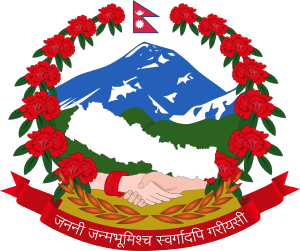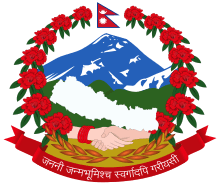Gaunpalika
Gaunpalika (Nepali: गाउँपालिका, romanized: gāunpālikā| translation: Rural municipal) is the newly formed lower administrative division in Nepal.[1][2] The Ministry of Federal Affairs and Local Development (Nepal) dissolved the existing village development committees and announced the establishment of this new local body. There are currently 460 rural municipalities.[3][4]
| Gaunpalika | |
|---|---|
| Also known as: Rural Municipality | |
 | |
| Category | Rural Municipality |
| Location | Nepal |
| Number | 460 (as of 2017) |
| Populations | 59,946 - 538 |
| Areas | 2,419.64 square kilometres (934.23 sq mi) - 15.48 square kilometres (5.98 sq mi) |
| Government | Rural Council |
| Subdivisions | Wards |
 |
|---|
| This article is part of a series on the politics and government of Nepal |
Executive:
Federal Parliament:
Judiciary:
|
|
Administrative divisions
|
|
|
|
Related topics |
|
|

Purpose
The main purpose of a gaunpalika is similar to that of a village development committee. Besides this, this division has the authority to collect various taxes like entertainment tax, business tax and residential tax at the local level.[5]
History
Dissolution of VDC
The Village Development Committee (VDC) was dissolved on 10 March 2017.[6] Previously, panchayat was dissolved and turned into VDC by the Constitution of Nepal 1990.
Origin of rural municipality
According to the English translation of the Constitution of Nepal, the term "gaunpalika" has been used as "village body". However, the Ministry of Federal Affairs and Local Development explained that the term "rural municipality" was coined after opinions from experts and diverse sources.[7]
Organization
The chief is the head of a rural municipality. A total of 744 chiefs were selected by the government in 10 March 2017.[2]
The rural municipalities will have an annual budget of at least Rs 10 million.[6]
List of gaunpalikas
See also
- Village development committees of Nepal topics
References
- "District Coordination Committee". MoFALD. Government of Nepal. Retrieved 1 June 2017.
- "गाविस/जिविस खारेज, ७ सय ४४ स्थानीय तह आजैबाट कार्यन्वयनमा". Nepal Aaja. Retrieved 12 April 2017.
- "Recently increased 22 local units published in Nepal Gazette". The Himalayan Times. Retrieved 26 May 2017.
- "481 chiefs appointed in rural municipalities" (18 March 2017). myRepublica. Nepal Republic Media Pvt. Ltd. 18 March 2017. Retrieved 12 April 2017.
- "स्थानीय निकाय भङ्ग, सिंहदरबारकै हैसियतका ७ सय ४४ स्थानीय तह क्रियाशील". Nepal Aaja. Retrieved 12 April 2017.
- "Government announces dissolution of VDCs, birth of village councils". Online Khabar. Retrieved 12 April 2017.
- "Gaunpalikas to be called rural municipalities" (15 March 2017). Himalayan Times. The Himalayan. Retrieved 12 April 2017.
